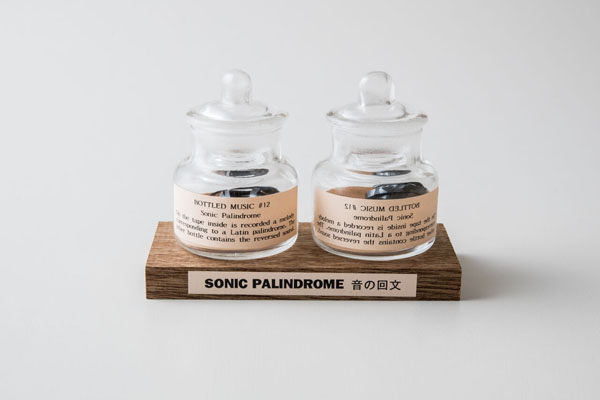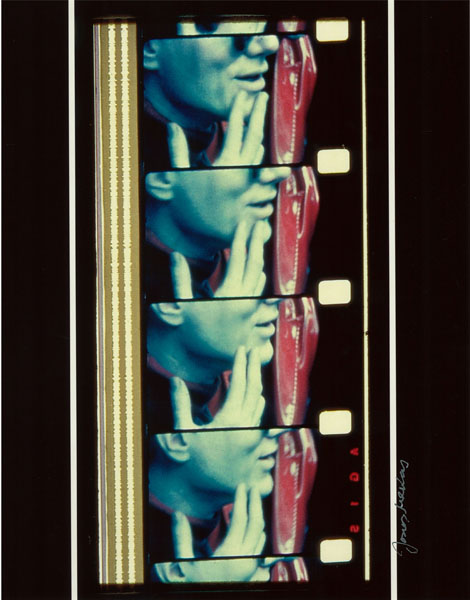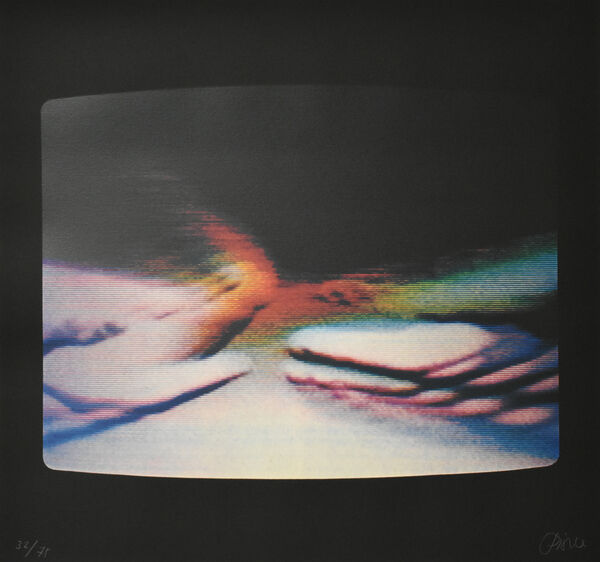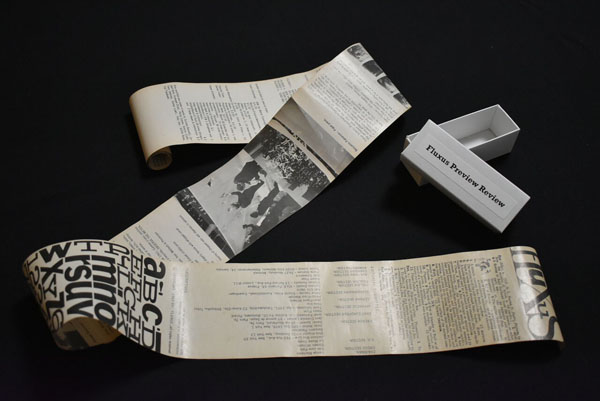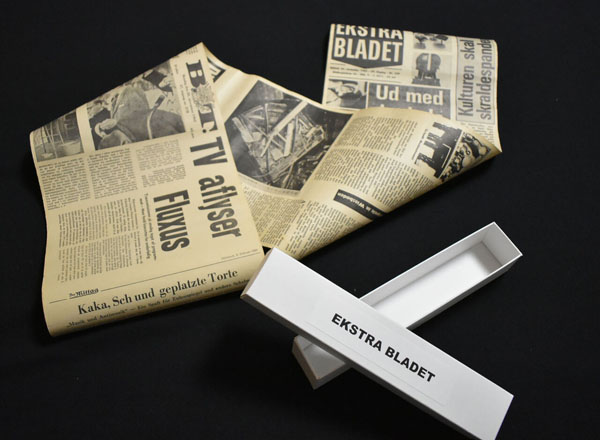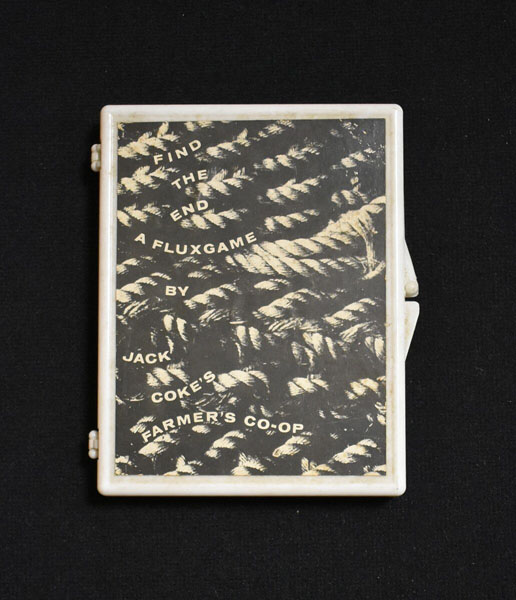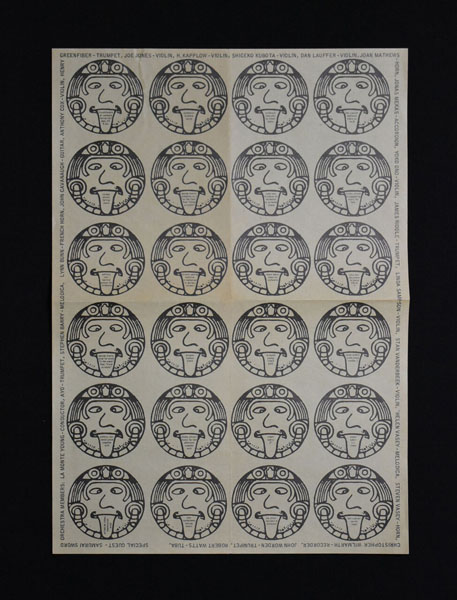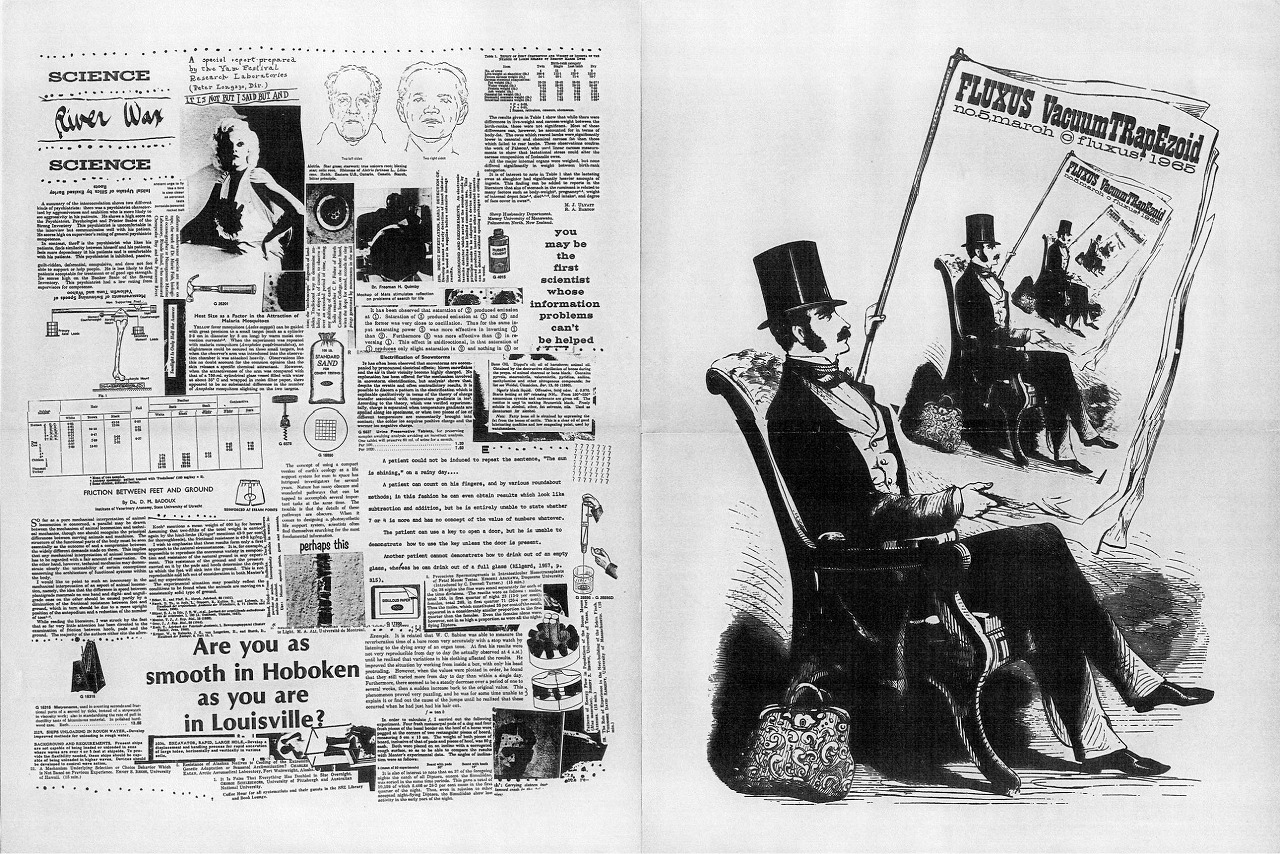Fluxus, now spread around
the world, is a group that began as a network of friends and acquantainces of the Lithuanian designer George Maciunas
when he thought to bring together those not bound to exisiting modes
of expression. The time of its inception, the 1960s, saw a growth of
economic luxury centered on the USA and Europe and a boom in
capitalist culture. Although the group had no set rules, they took a
general philosophy of "anyone can be an artist, anything can become
art", and the idea of "finding art in the banal" was counter to the
high art and fine art of the time. Maciunas wrote up a Fluxus
manifesto but did not require any artist to sign it. As a result,
though there were no particular rules, the lack of a strict order
allowed them to avoid fissures in the group. Fluxus' activity began
in 1962 with the FLUXUS FESTIVAL in Wiesdbaden, and has swept up
many artists ever since.
John Cage's influence on Fluxus has been particularly large, and
many of the students from his New School, such as Ichiyanagi Toshi,
became involved with Fluxus. Cage's most well-known work, "4'33"",
is a score which only consists of "tacet", directing silence. This
work has been performed at Fluxus concerts.
4 Japanese women -
Ono Yoko, Shiomi Mieko, Kubota Shigeko, and Saito
Takako - were members of Fluxus. Shiomi Mieko's book, "What is
FLUXUS", is an important document of that time from the point of
view of a participating artist. In 1965, the exhibition "FLUXUS
WEEK" introduced Fluxus to Japan. This exhibition saw the
participation of such artists as the former Jikken Kobo members
Akiyama Kuniharu and Yamaguchi Katsuhiro. Those close to Fluxus,
like Kubota Shigeko, Nam June Paik, and Ono Yoko intoduced Takamatsu
Jiro, Akasegawa Genpei, and Nakanishi Natsuyuki of Hi-Red Center to
members of Fluxus. In 1966, Fluxus performed a version of "Campaign to Promote Cleanliness and Order in the Metropolitan Area"
in New York with the name "Fluxfest Presents Hi Red Center Street
Cleaning Event". Ono Yoko's concept of "license", the idea that it
is not necessary for the artist herself to complete a work, was
greatly influential on the nature of Fluxus works.
Fluxus' activity developed over many mediums including music,
poetry, film, visual arts, and theater. With Maciunas at its center,
with the performances of many events, production of multiples, and
publishing of Fluxus Newspapers, the group spread across the borders
and identities around the globe. A unique characteristic of Fluxus
is the way that works are introduced to the world in forms such as
Fluxus artist boxes including "FLUXUS 1", "FLUXUS YEAR BOX", and
"FLUXUS KIT", and the printing of editions.
Following Maciunas' death in 1978, Fluxus continues to
gather attention, with exhibitions and related activities still held
around the world.
(Text by ICHIKAWA Ayana)
Fluxus related artists: AKIYAMA Kuniharu,
Dietrich ALBRECHT,
Eric ANDERSEN, Ay-O , Joseph BEUYS,
George BRECHT, John CAGE,
Henning CHRISTIANSEN, Philip CORNER, Merce CUNNINGHAM, Willem de
RIDDER, Francois DUFRENE, Robert FILLIOU, Albert FINE, Ian Hamilton FINLAY, Henry FLYNT, Ken FRIEDMAN, Al HANSEN, Bici HENDRICKS, Geoffrey HENDRICKS, Dick HIGGINS, Hi-red Center, Alice HUTCHINS, ICHIYANAGI Toshi, IZUMI Tatsu, Ray JOHNSON, Jo JONES, Allan KAPROW, Per KIRKEBY, Bengt af KLINTBERG, Milan KNIZAK, Alison KNOWLES, Arthur KOEPCKE, KOSUGI Takehisa, KUBOTA Shigeko, Fredric LIEBERMAN, Gyorgy LIGETI, George MACIUNAS ,
Jackson MAC LOW, Jonas MEKAS,
Larry MILLER, Peter MOORE,
Charlotte MOORMAN, Claes OLDENBURG, Yoko ONO,
Robin PAGE, Nam June PAIK, Ben PATTERSON, James RIDDELL, Terry RILEY, Dieter ROTH, Jerome ROTHENBERG, SAITO Takako, Tomas SCHMIT, Sara SEAGULL,
Paul SHARITS, SHIOMI Mieko, Daniel SPOERRI, TONE Yasunao, Roland TOPOR, Ben VAUTIER, Wolf VOSTELL, WADA Yoshimasa, Robert WATTS, Emmett WILLIAMS, La Monte YOUNGq

A chart of early Fluxus members.
(from "What is FLUXUS?―The people who brought together daily
life and art" / 2005, SHIOMI Mieko)
|

|
|
George MACIUNAS, Dick HIGGINS, Wolf VOSTELL, Benjamin PATTERSON, Emmet WILLIAMS
"Piano Activities" by Philip Corner
At the Fluxus International Contemporary Music Festival in
Wiesbaden
1962 (Photo by Hartmut Rekort)
("FLUXUS") |
|
|

|
|
George MACIUNAS
"40 Monograms Designed by George Maciunas"
Date unknown
12.0×10.0×1.4cm
ReFlux Editions Collection of Nagasawa Akio
("5 Year Gallery Opening Fluxus
Exhibition―From Art to Daily Life")
|
|
|
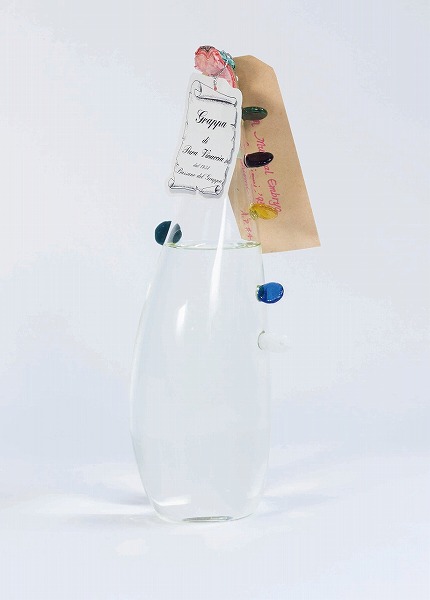
|
|
SHIOMI Mieko
GRAPPA FLUXUS
"A Musical Embryo"
1995
Mixed media
Bottle height: 28cm
Ed.4
Made for the Grappa Fluxus series planned by Edition Luigi
Bonotto. |
|
|

|
|
"FLUXUS1"
1964 ~
Mixed media, wooden box
22.4×24.0×5.4cm
|
 Exhibitions Exhibitions
2022
SHIOMI Mieko + FLUXUS 9/2~9/17
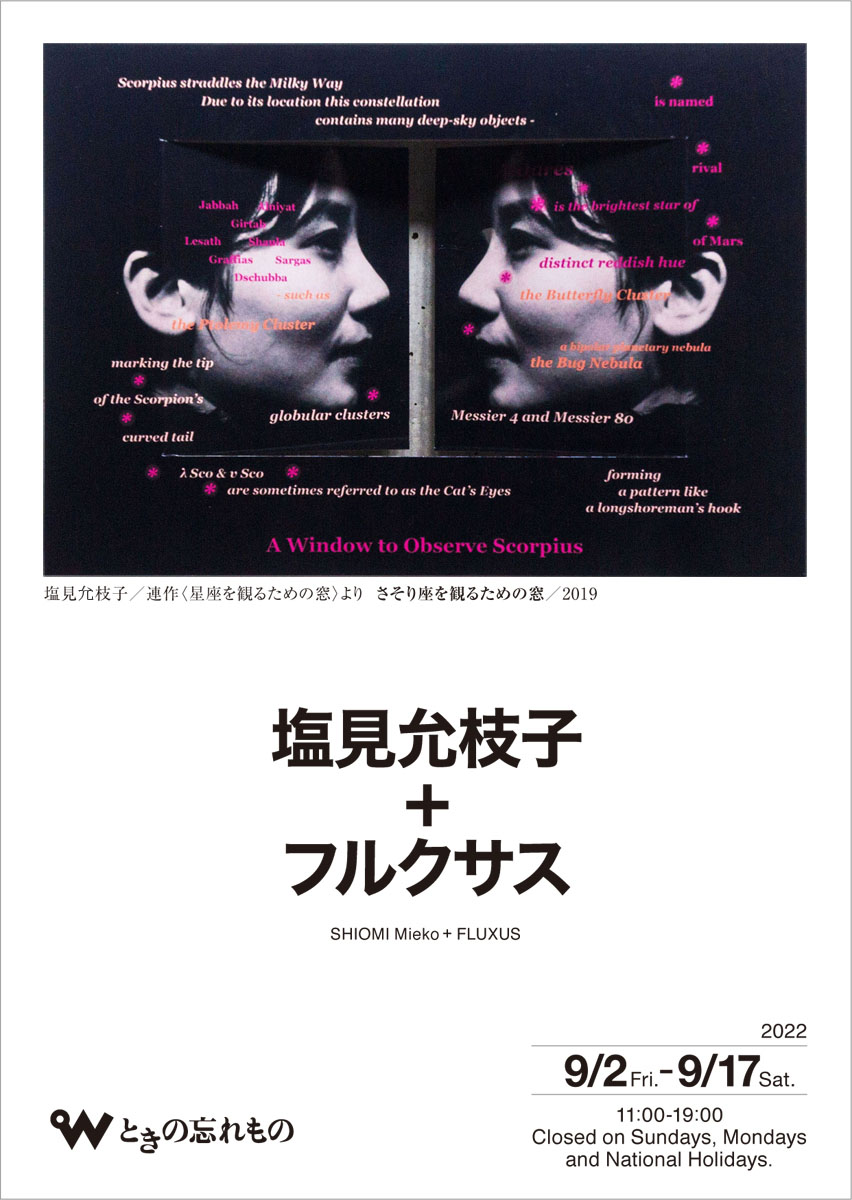
2021
Illustrated Book - Toki-no-Wasuremono Original Prints Exhibition 1/6~31/23
2020
Jonas Mekas
Exhibition 8/28~9/12
2019年
◆ART TAIPEI 2019 10/18~310/21
◆ART OSAKA 2019 7/6~37/7
In memoriam・Jonas Mekas Films Screening
2/5~2/9
2017
Weekly Special Collection:
Nam June PAIK and MOON Seung-Keun
8/18~8/19
◆ART on paper 3/2~3/5
2016
◆KIAF 2016/ART SEOUL 10/12~10/16
◆ART STAGE JAKARTA 8/5~8/7
◆ART BUSAN2016 5/20~5/23
◆Art Stage Singapore 1/21~1/24
2015
◆KIAF/2015 10/7~10/11
2014
◆KIAF 2014 9/24~9/29
◆ART OSAKA 2014 7/11~7/13
2013
Jonas MEKAS and his time Exhibition
12/18~12/28
2012
◆ART NAGOYA 2012
Jonas Mekas Exhibition Celebrating publication of "Jonas Mekas: Notes, Dialogues, Films" 12/6~12/8 8/4~8/5
◆ART OSAKA 2012 7/7~7/8
SALE
Ay-O, Q Ei, ONOSATO and artists of "DEMOKRATO". 3/17~3/18
Jonas MEKAS Photo Exhibition
2/10~2/25
WEB Exhibition
Ay-O Exhibition 2/1~2/29
2010年
◆KunStart 10 3/5~3/7
WEB Exhibition Jonas Mekas
Exhibition 3/16~4/15
WEB Exhibition Ay-O Exhibition 4/15~5/16
2009年
◆Daegu Art Fair 2009 11/25~11/29
◆KUNST 09 ZURICH 11/13~11/16
Jonas Mekas' New
Photo Works 9/1~9/19
2008年
◆ART OSAKA 2009 8/21~8/23
2007年
◆ART in DOJIMA/OSAKA2007 7/20~7/22
2005年
Jonas Mekas
Exhibition 10/14~29
2004年
Jonas Mekas Exhibition
2002年
Jonas Mekas Photo Exhibition―
He stands in the desert counting the seconds of his life 4/ 19~5/25
Jonas Mekas Exhibition- Prints and Photographs 3/1~3/16
|







